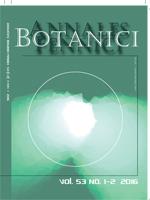Myosotis laxa s. lato (Boraginaceae) is a morphologically highly variable taxon. We examined whether, in the Baltic Sea region, the coastal form of M. laxa has a single centre of origin or if it has emerged due to landscape dissimilarity (sea/land ratio) and environmental factors independently in different regions. We used partial Mantel's test to investigate correlations between the genetic and phenotypic variability of M. laxa and the mentioned habitat factors. Although the correlation between genetic distance and the sea/land ratio existed (p < 0.01), it was not strong (r = 0.34). Phenotypic distance among populations was not correlated with habitat factors. Similarly, there was no correlation between geographic distance and morphological characteristics of the studied populations. As neither phenotypic nor genetic dissimilarity between sampled locations was correlated with geographic distance, we suggest that the coastal form can arise independently in suitable habitats and its development may be caused by epigenetic regulation. However, gene flow among the coastal and mainland populations most likely prevents stronger adaptive and genetic divergence.
How to translate text using browser tools
8 February 2016
Do Landscape Dissimilarity and Environmental Factors Affect Genetic and Phenotypic Variability in Myosotis laxa s. lato (Boraginaceae)?
Ene Kook,
Silvia Pihu,
Ülle Reier,
Marge Thetloff,
Tsipe Aavik,
Aveliina Helm
ACCESS THE FULL ARTICLE

Annales Botanici Fennici
Vol. 53 • No. 1–2
April 2016
Vol. 53 • No. 1–2
April 2016




